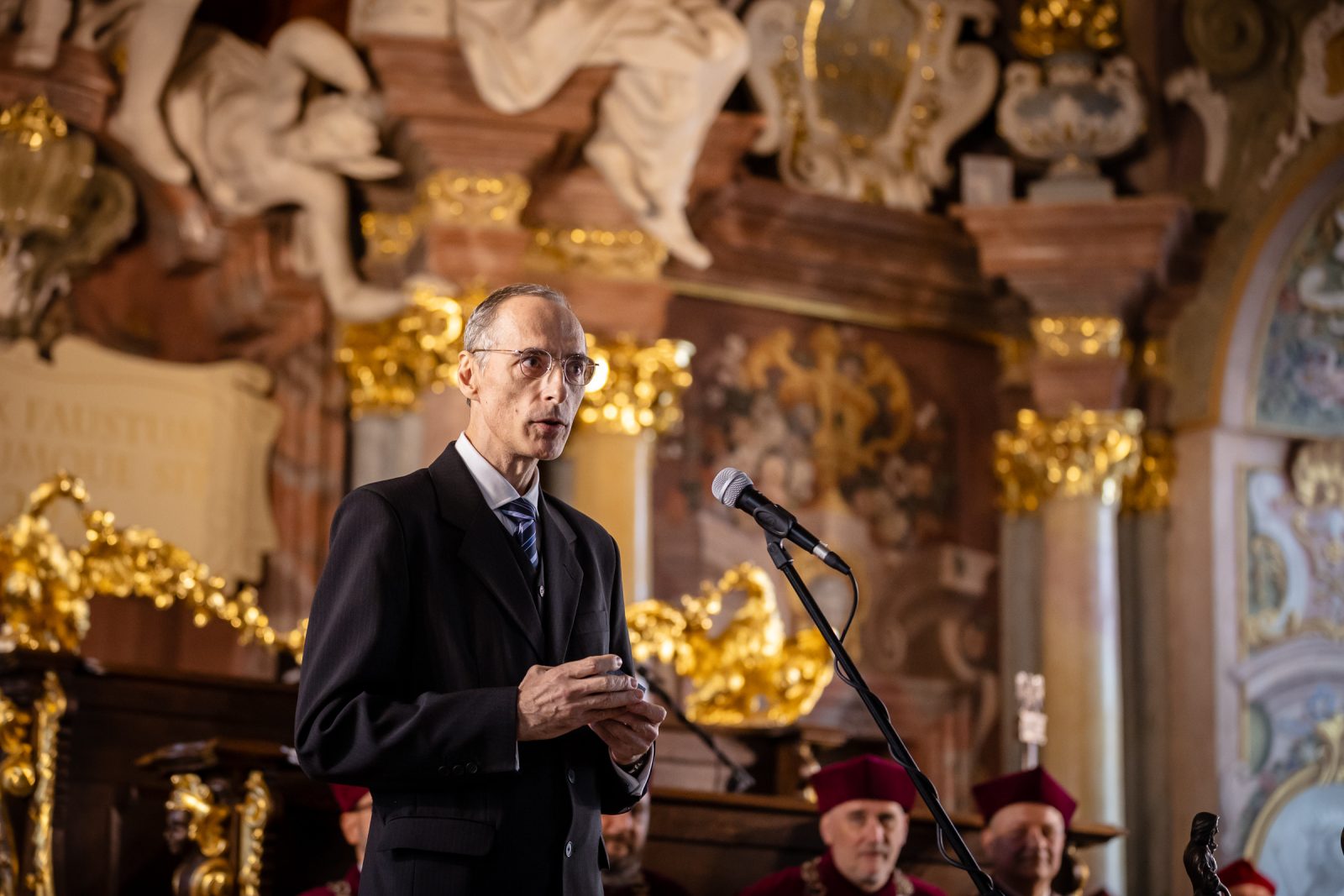
Heisig Prize for a physicist from Adam Mickiewicz University in Poznań
The Heisig Prize for a physicist from Adam Mickiewicz University in Poznań
The award was presented on 1 October 2025 during the inauguration of the academic year at the University of Wrocław by professor Robert Olkiewicz, Rector of the University of Wrocław, and Constantin von Kessel, Chair of the Board of the Norbert and Barbara Heisig Foundation.
The Heisig Prize honours Polish scholars conducting research of the highest international calibre whose discoveries have made a significant contribution to the advancement of science. The initiator and sponsor of the award is professor Norbert Heisig – Honorary Senator and Honorary Doctor of the University of Wrocław, founder and long-time president of the German–Polish Society of the University of Wrocław.
Established in 2020, the Heisig Prize is awarded biennially by the University of Wrocław. Candidates are nominated by universities participating in the Excellence Initiative – Research University programme.
This year marked the third edition of the Heisig Prize. Its aim is to recognise a researcher whose work demonstrates innovation in a field of major relevance to the contemporary world, has been acclaimed by the academic community, and has culminated in a concrete scientific achievement.
In the third edition of the Heisig Prize, the Curatorium appointed by the Senate of the University of Wrocław – composed of professor Beata Baczyńska, professor Piotr Biler, professor Elżbieta Gumienna-Kontecka, dr hab. Paweł Jałoszyński and professor Krzysztof Redlich – after analysing reviews and documentation of the candidates’ scientific achievements, nominated two scholars for the award:
- professor Paweł Kulesza from the University of Warsaw, representing the chemical sciences – electrochemistry, inorganic and analytical chemistry, and materials engineering. He was nominated in recognition of his discovery and comprehensive description of charge propagation in functional materials with broad potential applications in energy conversion and storage processes; and
- professor Adam Miranowicz from Adam Mickiewicz University in Poznań, representing the physical sciences – quantum optics, quantum information theory, and cryptography. He was nominated for his pioneering research on the theoretical and empirical foundations of quantum technologies, particularly for developing new methods for the generation, control, and detection of quantum states of single photons, and for the fundamental discovery of the possibility of ultra-strong coupling between light and matter and its applications in quantum dissipative engineering.
From among the nominees, the Heisig Prize Committee appointed by the Founder – composed of Constantin von Kessel, Chair of the Board of the Norbert and Barbara Heisig Foundation; professor Robert Olkiewicz, Rector of the University of Wrocław; professor Zdzisław Latajka, Rector of the University of Wrocław (2002–2005); Jacek Sutryk, Mayor of Wrocław; and dr Maciej Łagiewski, Director of the City Museum of Wrocław – selected professor Adam Miranowicz as the laureate of the third edition of the Heisig Prize.
Professor Adam Miranowicz was recognised for his pioneering research into the theoretical and empirical foundations of quantum technologies, including, among others, the development of new methods for generating, controlling, and detecting quantum states of single photons, as well as for his fundamental discovery of the possibility of ultra-strong coupling between light and matter and its applications in quantum dissipative engineering. His work has introduced innovative methods enabling, among other things, quantum light squeezing, the generation of quantum entanglement, and the development of superconducting quantum circuits. These discoveries have applications in emerging quantum technologies, sensors, information processing, quantum metrology, and quantum computing. Many of his ideas have been confirmed both theoretically and experimentally in laboratories in the United States and the European Union.
For his outstanding scientific achievements, professor Miranowicz has received, among others, the Wojciech Rubinowicz Scientific Award (2019) and the Prime Minister’s Award (2021).
To recall previous laureates: the winner of the first edition of the Heisig Prize was professor Jan Potempa from the Jagiellonian University, honoured for discovering the biochemical mechanisms linking bacterial periodontal disease to autoimmune reactions, opening new perspectives in the fight against Alzheimer’s disease.
The second edition of the award went to professor Cyryl Lechosław Latos-Grażyński from the University of Wrocław, recognised for discovering the structural distinctiveness of porphyrins, which led to the creation of innovative structures with broad research and application potential.
Speech by the Heisig Prize Laureate, Professor Adam Miranowicz
Ladies and Gentlemen,
Allow me to deliver my remarks in English, out of respect for our distinguished international guests.
Your Magnificence, Rector of the University of Wrocław, esteemed rectors of other universities, honourable members of the Prize Committee, distinguished guests, dear students, ladies and gentlemen – receiving this year’s prestigious Professor Norbert Heisig Prize is for me both a great honour and a source of profound joy. I accept this distinction not only as recognition of my personal contribution but also as an appreciation of teamwork and, more broadly, of the entire field of quantum technologies – with particular emphasis on theoretical and foundational research.
I would like to dedicate this award to my mentors and early academic advisers: the late Professor Stanisław Kielich and Professor Ryszard Tanaś of Adam Mickiewicz University in Poznań, as well as Professor Stephen Barnett of the University of Oxford. I also wish to express my deep gratitude for the long-standing and fruitful collaboration with many researchers abroad. In particular, I would like to mention Professor Franco Nori, Chief Scientist at the RIKEN Institute in Saitama, Japan, with whom I have been collaborating for almost twenty years, resulting in over one hundred joint publications. It is thanks to this enduring and inspiring partnership that I am able to stand before you today.
Our research places strong emphasis on theoretical analysis, and it is immensely satisfying that many of our predictions have been experimentally confirmed by collaborating teams in various research centres. We have worked closely, among others, with the group led by Professor Karel Lemr at Palacký University in Olomouc, which has successfully implemented several of our quantum protocols in linear optical systems, and with Professor Yueh-Nan Chen’s group at NCKU in Taiwan, where our models are tested using IBM’s superconducting quantum computers and the Quantinuum ion-trap quantum computer.
I would also like to acknowledge the work of our Poznań-based team, currently headed by Dr habil. Karol Bartkiewicz – my former doctoral student and now Head of the Department of Quantum Information – who conducts online experiments using American quantum computers. Importantly, our theoretical predictions have also been confirmed by independent research groups around the world, including those in New Haven, Boulder, Chicago, St. Louis, Paris, Grenoble, Wuhan, Shanghai, and Tokyo.
My very first scientific paper, written thirty-five years ago together with Professors Kielich and Tanaś, dealt with the so-called Schrödinger’s cats and kittens. It was a purely theoretical concept that was experimentally verified only twenty-four years later at Yale University. Sometimes, therefore, it takes nearly a quarter of a century for theory to be confirmed. Fortunately, technological progress is now so rapid that many hypotheses can be tested within just a few years – or even months.
Allow me to briefly explain the essence of quantum technologies. Although they are often considered a recent development, their history stretches back almost a century. As early as 1931, Ernst Ruska and Max Knoll constructed the first electron microscope, which today is widely used to study viruses and even individual atoms. Quantum technologies also play a vital role in medicine. Magnetic resonance imaging (MRI, or NMR) relies on quantum effects related to spin and coherence, and almost every hospital today has such a scanner. Functional MRI (fMRI) can even visualise brain activity – showing that different areas are activated when we speak, listen, or engage in discussion.
Even more fascinating is the medical application of matter–antimatter annihilation. Although it may sound like science fiction, PET scanners – positron emission tomography – which are based precisely on electron–positron annihilation, operate in major hospitals, including here in Wrocław. The resulting photons are detected and used to image internal organs, heart function, and even brain activity.
The difference between the first and second generations of quantum technologies lies in the transition from collective control of many particles to manipulation of individual photons, ions, or superconducting qubits. We employ such extraordinary phenomena as quantum entanglement – once described by Einstein as “spooky action at a distance” – which has now become a fundamental resource of second-generation quantum technologies. We also make use of light squeezing, and even vacuum squeezing – which may sound paradoxical, since in classical physics a vacuum is empty space. In quantum physics, however, even emptiness contains fluctuations that can be compressed to enhance the precision of measurements and computations.
The famous Schrödinger’s cat paradox – illustrating the superposition of states – is no longer merely a philosophical curiosity. Such quantum superpositions can be harnessed for ultrafast quantum computing and for strengthening the interaction between light and matter. These studies have potential applications in medicine, information technologies, and many other areas.
In conclusion, I would like once again to express my heartfelt thanks to the Prize Committee for this exceptional honour, to my collaborators around the world for their long-standing friendship and shared achievements, and above all to my family, whose support gives me strength and motivation to continue my work.
Thank you for your attention.
Read also: We have begun a new academic year!
and A scientist from Adam Mickiewicz University awarded the Heisig Prize
Date of publication: 6.10.2025
Dodane przez: M.K.



